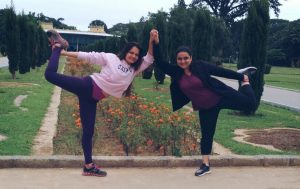
In the Ashtanga system of yoga as propounded by Shri K. Pattabhi Jois, you practice backbending daily. In the closing series, you practice the Urdhva Dhanurasana followed by the Sarvangasana and Halasana.
If you’ve been following me on Instagram and Facebook, you know that I’m focusing on my backbends a lot these days. Backbends have always been challenging for me, and for this reason I favor forward bends in my practice. It’s easier to do the stuff that comes naturally to you. But doing that which you know you’re not good at, now that requires real discipline.
I have forever intended to work on my backbends in my personal practice, but I never got around to it. But in Pune we devote an entire week of the month to backbends. So you see advanced practitioners doing the Urdhva Dhanurasana 108 times etc. There was one particular class that I feel changed my practice forever. My spine became accessible and I became open to the idea that I CAN do backbends in this lifetime. I resolved to continue the practice and I practice a back bending routine on most days. You can see a snapshot of a typical backbending practice in this video.
I often see students lamenting their inability to bend backwards (I’ve been there myself). Over the years I’ve learned that when it comes to bending back, more doesn’t always mean better.
The flexibility of your spine can give you a clue about how you approach life. Do you have a tendency to bend over backwards to accommodate people and situations ? Bending like you don’t have a spine can also be described as being ‘spineless’. Conversely, are you unable to bend back at all? Not able to be open to an uncomfortable situation or a different point of view?
In terms of yogasanas, a certain amount of resistance is necessary to execute the full expression of the asana. A body which can fold easily at every single joint has to work hard to provide the counterforce to hold an asana steady. So we see the inability to gauge the centre in Sirsasana and Natrajasana. We see an inability to hold Parsvakonasana.
Being too flexible is not always a good thing. Too flexible with your time, with your emotions, with your boundaries, with yourself…


